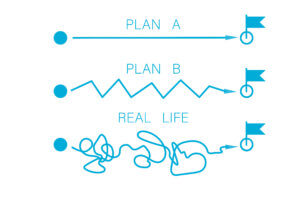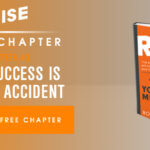Resilience determines whether you succeed or fail in life. It’s true in sports, business, and entertainment, and it’s true in your life.
Many early theories about resilience and ‘being resilient’ stressed the role of genetics. Some people are just born resilient, so the argument went. There’s some truth to that, of course, but empirical evidence today shows that anyone can learn resilience.
In reality, you sometimes don’t realise how much resilience you have until you are tested. As the saying goes: cometh the hour, cometh the man.
How to build resilience
There are many arguments about what makes one individual more resilient than the next. In my experience, building resilience comes down to three things;
#1 Confront reality head-on
Individuals with a strong bias and an abundant reservoir of personal resilience live their lives in a constant state of reality.
They don’t bury their head in the sand when faced with challenging times. They don’t go into denial, hoping that a situation or scenario will sort itself out. And they’re never delusional about the magnitude of their opportunities or challenges. They have a unique ability to confront reality head-on.

They are what I call the ‘pragmatic optimist’.
A common belief is that resilience stems from an optimistic mindset. While that’s true to a point, it only applies when optimism doesn’t distort reality. In extreme scenarios and situations, rose-tinted thinking can spell disaster. Resilient people have a serious and down-to-earth view of those parts of reality that matter.
Now, this is not to diminish optimism. A sense of optimism and possibility is a powerful tool when turning around a demoralised team or helping an individual through a difficult time.
But a relaxed, calm, almost pragmatic sense of reality is critical to your success in more significant challenges. I consider the resilient, high achiever the pragmatic optimist, where both characteristics work in positive tension to benefit both. (check out my blog on high achievers for more of their key traits)
Do you truly understand and accept the reality of your situation and the scenarios you face personally and professionally?
Do you confront reality head-on?
We all tend to slip into denial as a coping mechanism. Facing reality is gruelling work. It can often be draining and emotionally wrenching. But once you confront reality, you have a robust platform from which to build.
#2 Have an unwavering belief that your life is purposeful
Creating purpose is the way resilient people build bridges from their current state of reality to a compelling future state. The moment you create the bridge – the link between your personal goals, business goals, and what you do daily during work – self-motivation takes hold. This is the defining moment you change from someone with a job to someone with a purpose.

Your resilience will naturally kick in when your purpose is challenged or under threat.
#3 Improvise and adapt
One word, bouncebackability.
Yes, you read that correctly. It is an accurate word, albeit a recent addition to the English dictionary.
Its official definition is; the ability to be successful after a period of failure.
It was first coined by ex-footballer Iain Dowie when he was the manager of Crystal Palace Football Club, who famously described his team as showing ‘… great bouncebackability’.
Behind the great success are years of dedication, trial and error, mistakes, successes and setbacks. Achievers don’t always get it right; in some situations, they might fail (or what others perceive as failure).
I know I have experienced stunning successes and some fantastic failures in my life. But I view the failures as learning opportunities, stepping-stones to the ultimate goal. And remember, if plan A doesn’t work, then the great news is there are 25 more letters in the alphabet.
Imagine a rubber ball.

The harder the ball hits the ground, the higher it bounces back.
That’s bouncebackability!
You’re going to take knocks, some days will feel like a train crash, and you will go down blind alleys. But suppose you have an ultimate destination in your mind’s eye, a focused goal and purpose coupled with drive, determination and motivation. When you fall over, you’ll pick yourself up, dust yourself off, improvise, adapt and refocus on your goal.
That’s resilience in action!

